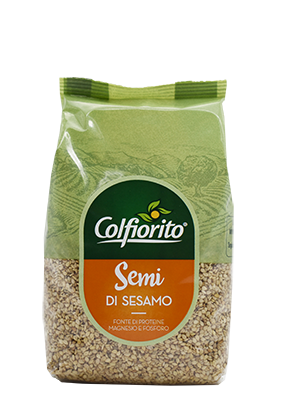- Land
- Territory
- Creativity
- Sustainability
- Sustainable world
- Global Compact
- FAO Partnership
- Zero-Impact Emissions
- Circularity and conscious Packaging
- On the front lines against waste
- Growing together with a whole territory
- Code of ethics and model 231

Sesame seeds have been used till ancient times to enrich meals, decorate them, and/or as a nutrient-rich food. Used in thousands of recipes from far east to the mediterranean, till oversea in the iconic burger buns, they are an ever-present superfood in our recipes, which is more and more valued as an ingredient.
Sesame Seeds.
May contain Mustard and Celery.
Keep seeds closed in a cool dry place, away from heat and light sources.
Sesame seeds are a great source of proteins and fibres, as well as important minerals such as magnesium and phosphorous. They're very easy to use as a topping for salads or soups, but also homemade bread, as a fancy coating for meat, fish steaks and fresh cheese, but also sweet courses.
Sesame seeds are ideal as ingredients for homemade breads and other baked recipes, both in the dought and as garnishing. They are great in meat and fish preparation, like coating tuna or beef filler, or to enrich vegetables - even algae, as in oriental cuisine. They are the main ingredient of Tahina, the mediterranean base for chickpea Hummus, as well as together with beans Falafel.
Here are the nutritional information:
| AVERAGE VALUE | PER 100g | PER PORZIONE |
|---|---|---|
| Energy | 2397 kJ / 537 kcal | 719 kJ / 172 kcal |
| Fats | 49,6 g | 14,9 g |
| of which Saturated | 7,0 g | 2,1 g |
| Carbohydrates | 23,45 g | 7,0 g |
| of which Sugars | 0,3 g | 0,1 g |
| Fibres | 12,0 g | 3,6 g |
| Proteins | 17,8 g | 5,3 g |
| Salt | 0,03 g | 0,01 g |
| Magnesium | 351mg (93% VRN)** | 105 mg (28% VRN)** |
| Phosphorous | 629 mg (90% VNR)** | 188,7 mg (27% VNR)** |